 |
|
||||||||||
|
 |
|
||||||||||
|
English for Success Courseware
| Title | English for Success | 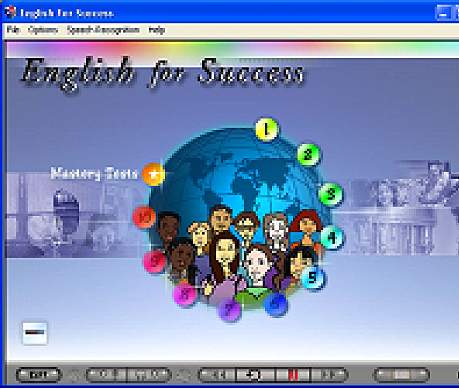 |
| Author | DynEd Interactive Language Courses | |
| Contact Information | Email: for US, Canada, Caribbean and Latin America: sales@dyned.com or info@dyned.com; japan@dyned.com; asia@dyned.com; europe@dyned.com | |
| 1-800-765-4375 for technical support Japan: 81-03-3478-2448 Europe: 44-1844-208-495 France: 33-(0)-4236-7826 DynEd International, Inc: http://www.DynEd.com | ||
| Product Type | Multimedia CD-ROM, Teacher's Guide, Student Study Guide | |
| Platform | Windows, Macintosh | |
| Minimum System Requirements: | Windows —
Windows 95, 98, 2000, NT, Me and XP Pentium 200Mhz with 64 MB of RAM Quad speed or faster CD-ROM drive 16-bit sound card and microphone Speakers or headphones Mouse or touchpad |
Macintosh — MAC OS 8.6 or later, and OS X 200 Mhz Power PC 64 MB or RAM OS x 10.1.4: 300 Mhz/128 MB RAM Quad speed or faster CD-ROM drive Speakers or headphones Mouse or touchpad, microphone |
| Price | $480.00 USD for one user; price is adjusted for multiple simultaneous users. | Determined by number of simultaneous users. Call 1-800-765-4375 for specific pricing. |
English for Success is a program designed to help English Language Learners (ELLs) ages 11-18 acquire the language they need for success at school--in their classes and with their new schoolmates. It is based on brain and language acquisition research, exploiting both to form a blended model where multimedia activities and classroom interaction complement each other. The language structures and vocabulary provided are specific for the content classes and for social situations that normally occur in classroom situations.
It is common for ELL students to acquire basic English, but it is uncommon that they fulfill their academic potential (Suarez-Orozco, 2001; Cummins, 2001). This comprehensive program addresses their need for a boost in academic and social language for academic use as they move into an English-speaking education system.
There are two installation discs, one for the English for Success courseware and one for the "Records Manager"; the "Records Manager" program is included to monitor student progress. Users insert the discs, click on "Help" to see "Documentation", click on "Install", enter an installation code, and register the course. An icon for each program appears on the desktop. [-1-]
Navigation through the program is intuitive: the icons, menus, and directional symbols foster independent use so that a student unfamiliar with computers will be able to work comfortably with little instruction. Keyboarding is not required. There are options for repeating, pausing, exiting, "bookmarking", and viewing the written text of an audio narration, with easy access to the multilingual glossary. The program includes a speech recognition element that is intuitive to use as well. Each user's progress is saved so they can easily start up where they left off from a previous session. Lessons are timed, but the pause button allows students to modify the time they need for processing new material. There is a help feature for each lesson to support students and teachers, and it includes a guided tour of the program.
There is a balance and representation of cultural, ethnic and racial groups in the characters used within the program, and concepts and vocabulary are tailored to student needs, interests, and abilities. The characters have personality traits often seen in students: one who doesn't like to study, one who is serious, one who has trouble with science, et cetera. Their voices are engagingly adolescent. The narrators' speech is exceptionally clear and easy to understand, although one of them has a regional pronunciation for /e/ that is jarring and could occasionally affect an ELL student's comprehension and spelling: ind for "end", sintence for "sentence", miny for "many", et cetera. The content areas on which the program focuses are standard for middle school and high school curricula and provide accurate, basic information with content-specific vocabulary and terms.
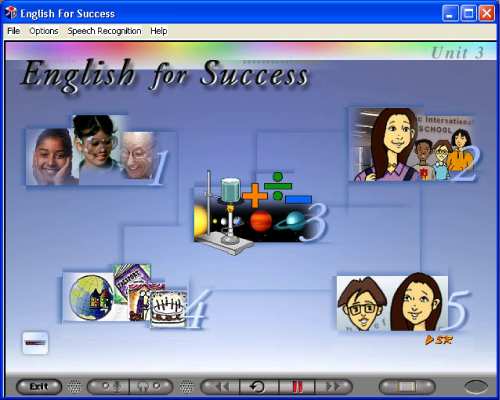
The program consists of ten increasingly advanced units. Students click on the appropriate unit and a screen appears with five choices for study: Warm-Up lessons, School-Life lessons, School-Subject lessons, World Talk Cards and Language Extension lessons, and Speaking Up lessons. There is constant audio support and feedback which users can choose to replay. If they want, they can see audio input in written form by clicking on the 'book' symbol, and can see it in their heritage language by clicking on their country's flag. Language options include: English only, Japanese, Italian, Korean, French, Portuguese, Mandarin, Spanish, and Turkish. Frequent comprehension checks are an integral part of each lesson and assure that students will receive reinforcement with the correct language and vocabulary before advancing. Although students may return to a lesson, they will find that it is slightly different upon each visit, as the program rearranges the information automatically. [-2-]
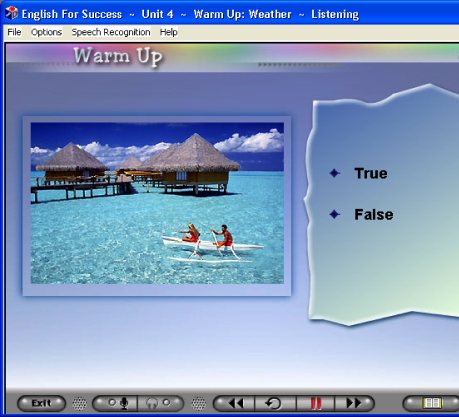 | 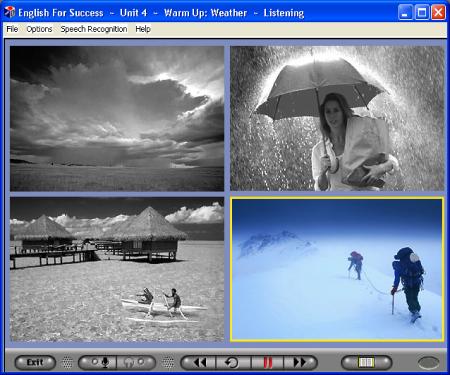 |
| [Figure 2] Warm-up sample | [Figure 3] Comprehension check |
In the Warm-Up lesson, a narrator (Figure 2) describes a scene, pausing about three seconds between statements for student processing. "It's very hot. It's very hot. The sun is shining and the water is clear." The next screen shows the same image with responses to an audio question. The student clicks on an answer. If it is incorrect, the student will hear, "No, that's not correct. Please try again." When the answers are correct, an encouraging voice will say, "That's right!" or another will say, "Good!" Then a new image appears and the process is repeated.
After four images and questions, a comprehension check (Figure 3) appears and students click on pictures, which correspond to audio statements. Graphics are designed to foster comprehension. Here, a picture lights up when it is the subject of narration.
These lessons focus on conversational English for school situations. The one pictured below (Figure 4) provides vocabulary and syntax for questions about class schedules and structures that transfer to other contexts. Other School-Life lessons focus, among other topics, on: school lunch menus, a school map, and making appointments. [-3-]
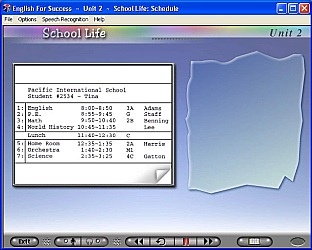 | 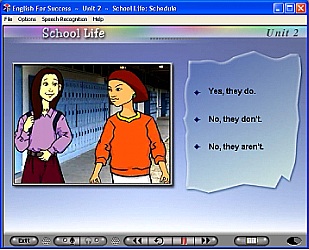 |
| [Figure 4] Class schedule | [Figure 5] Dialog |
Here the narrator discusses Tina's schedule--what her first and second classes are, the time they meet, what time lunch occurs, and what time her last class meets.
In the dialogs, somewhat animated graphics (the mouths, heads and hands move) show students having conversations about their schedules. After four statements, the user answers an auditory question relating to the conversation (e.g., "Do they have the same math teacher?"). The narrators include the questions in their feedback: "That's right. They both have the same math teacher," further exposing students to the target syntax and vocabulary. The second dialog employs the same language in slightly more complex forms.
School-Subject lessons focus on math, English grammar, science, world history, and geography. Key vocabulary and grammar forms are recycled for each lesson, giving students exposure to the material in different contexts. The basic explanations also provide background knowledge for students who lack it.
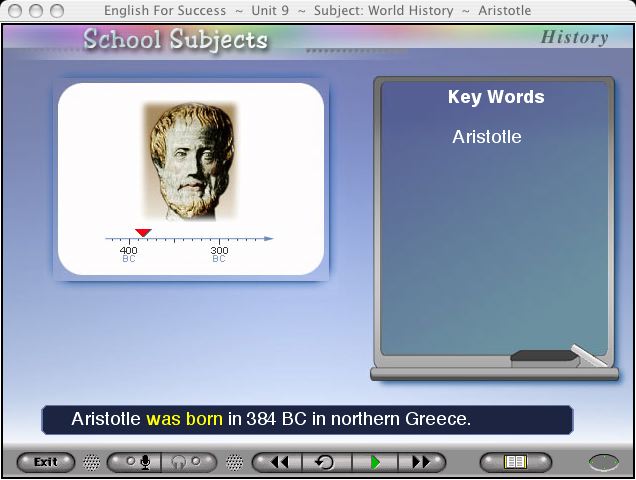
[Figure 6] Written Text Option
Students learn the language of school instruction: explanations, giving examples, classification, comparisons, asking questions, and more. Lessons cover various areas of a subject--like math for instance will offer lessons on: geometric shapes, positive and negative numbers, fractions, temperature, measuring, and others--and will provide the key terms for each: line, side, angle, for example, for triangles. [-4-]
World Talk Cards and Language Extension lessons offer general topics such as preferences, weather, occupations, and places of business. The language is presented in a game format, usually "Concentration" (Figure 7) and, like all the lessons, has frequent checks for comprehension. After the game, a grammar focus lesson explicitly addresses correct usage.
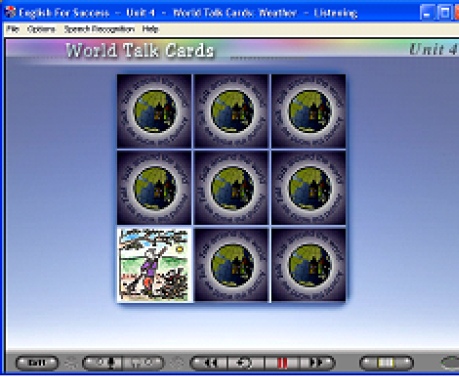 | 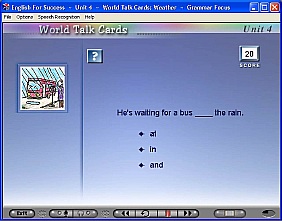 |
| [Figure 7] Concentration Game | [Figure 8] Grammar Focus: Session 1 |
To play "Concentration" in the listening practice section, a narrator makes a statement about the cards one at a time until all the cards are visible. Then the cards are covered again and the narrator asks the user to click on the card that corresponds to an audio statement. When the card is revealed, the statement is repeated in the affirmation, "Yes, that's right. "He's waiting for a bus in the rain." Or, "He's waiting at the bus stop, and it's raining."
For the grammar focus, students have several opportunities to practice this language in increasingly difficult forms as they return for new sessions with the same unit.
This section allows students to profit from speech recognition technology (Figure 9) to practice and perfect their speaking fluency and accuracy. It is not a pronunciation program, although students can compare their speech to the narrator's. There are three levels of expertise: beginner, intermediate, and expert. With each advancing level the feedback is more detailed and demanding.
Language that is developed in other lesson types is reiterated here, requiring the user to think and produce original responses which are, however, prompted. In this lesson from Unit 5, the girl on the left has asked Tina what class she has next. The user needs to choose the correct response and give it orally. [-5-]
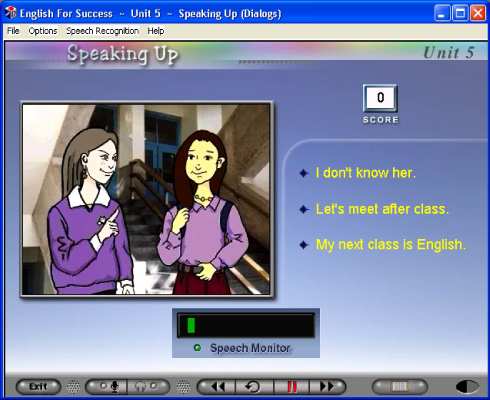
[Figure 9] Voice Recognition
By Lesson 10, the demands for speaking are more challenging. Students have to arrange the grammatical elements to form questions and responses themselves. Then they click prompts in the order they have chosen and a narrator's voice says, "Yes! That's right!" "In what year did Alexander die?" Users receive several reminders to respond. If they do not, the narrator will say, "Good bye. See you next time."
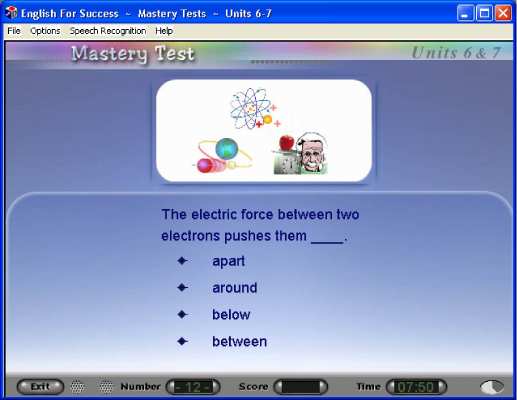
[Figure 10] Content Question
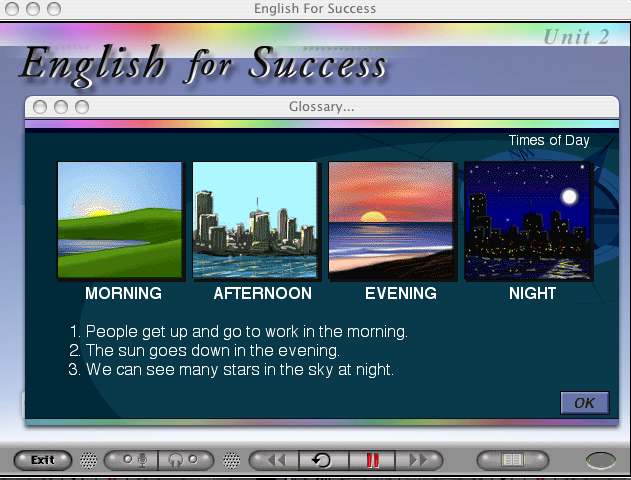 | 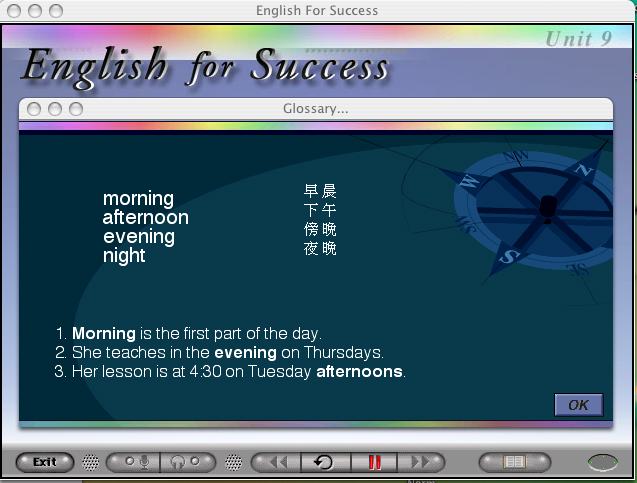 |
| [Figure 11] English explanation | [Figure 12] English/Mandarin |
The glossary is available in eight languages. They can be accessed after logging on by scrolling down to "Glossary" and selecting the desired language. The graphics make the meaning clear in English, but in other languages only the written translation is given, as seen in Figure 12.
The "Records Manager" is a strong feature of English for Success. It is programmed to record and analyze student activity and progress. A teacher can click on the students' names to see how many minutes they have spent on each lesson and how they scored on the quizzes and mastery tests. The teacher is able to focus on guiding student learning with management details already in place. Individualized instruction is facilitated. [-6-]
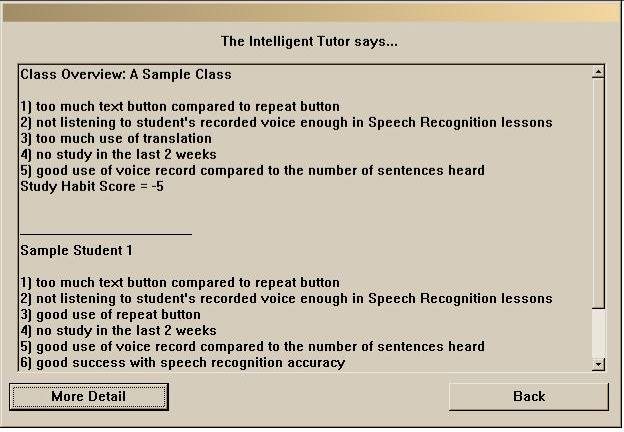 | 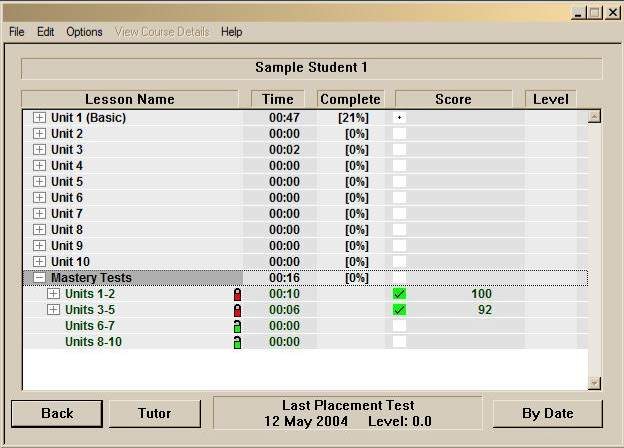 |
| [Figure 13] Intelligent Tutor | [Figure 14] Single Student |
Details are available for individuals or for the whole class. As the reviewer, I can say that the analysis the program created for my work was accurate. The tests provide times and unit scores. The teacher would need to conference with a student to know what about the unit or session was difficult. In other words, the assessment will help to pinpoint appropriate instruction.
The Help feature is a genuine asset. Explanations are thorough and available in the eight languages represented in the software. For teachers, instructional strategies are suggested, along with explanations of the research DynEd used to create the program. Explanations do not help with the subject matter, but they explain how to use the software features for the lesson and how to gain control of the material.
This program has been analyzed in terms of research on academic achievement, particularly for ELL students, with a look towards its potential to produce concrete results in student learning.
It is marvelous to find a software program that addresses ELL academic achievement and does it so well. English for Success attends to important features of language learning: comprehensible input, speech production, listening, repetition, and vocabulary development. It succeeds in making lessons clear with high-quality, supportive visuals, and screen displays that are uncluttered, engaging and varied. The pause button, which students can use for repetition and to gain mastery over a baffling expression, further supports comprehension. In addition to promoting listening comprehension, the design of the voice recognition system helps new English speakers become confident about producing language. They can practice all they want until they are comfortable with troublesome structures. Previously introduced language is spiraled throughout the program to produce mastery.
To assure constant engagement individual presentations are short--4-6 minutes--with varied, interesting and frequently changing formats that are culturally and ethnically inclusive. The regular, encouraging feedback and constant audio input are stimulating and promote confidence. DynEd recommends sessions of 20-30 minutes at most, so that students remain alert and are able to absorb what they have studied.
The difference between basic language and academic language is that basic language is highly supported by context and is pragmatic. English for Success supplies basic language for school. The school subjects addressed are concrete in nature, and the material presented supports the acquisition of operational skills and factual information. Greek and Latin-based words, which are important in academic contexts, are mostly absent. [-7-]
Academic language, which ELL students need, is more abstract and context-reduced; meaning is made with language itself (Cummins, 2000). That language too is largely missing in this program, even in the most advanced lessons. It would have been exciting if DynEd had required students to produce definitions, for example, or had exposed them to the expressions used in defending propositions. Such structures and patterns of thinking enhance the potential for ELL students' academic achievement and would have been easy to incorporate into the existing English for Success framework.
This is not a weakness; the program is outstanding and is a useful tool. Giving explanations, providing examples, classifying, comparing, and asking questions are developed in the program and will help with more in-depth work. However, English for Success would be even stronger if it explicitly supported the higher levels of cognitive function in academic areas, especially for the students who are the designated users of this program, ELL students ages 11-18. Teachers need to know that they alone will provide this language for their students.
Cummins, J. (2000). Language, power and pedagogy. Toronto: Multilingual Matters, Ltd.
Ellis, R. (1994). The study of second language acquisition. Oxford: Oxford University Press.
Ganske, K. (2000). Word journeys: Assessment-guided phonics, spelling, and vocabulary instruction. New York: The Guilford Press.
Snow, C.E., Cancino, H., De Temple, J., and Schley, S. (1991). Giving formal definitions: A linguistic or metalinguistic skill?, In E. Bialystok (Ed.), Language processing in bilingual children (pp. 90-112). Cambridge: Cambridge University Press.
Suarez-Orozco, C., Suarez-Orozco, M. (2001). Children of immigration. Cambridge, MA: Harvard University Press.
Valencia, R., (Ed.). (2002). Chicano school failure and success. New York: RoutledgeFalmer.
Kathleen Stark
Baraboo, Wisconsin (USA)
<Strk79@aol.com>
|
© Copyright rests with authors. Please cite TESL-EJ appropriately.
Editor's Note: Dashed numbers in square brackets indicate the end of each page for purposes of citation.. |
|
||||||||||